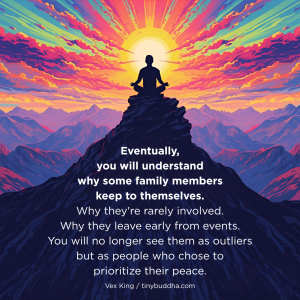
“Sometimes the most important thing in a whole day is the rest we take between two deep breaths.” ~Etty Hillesum
Today I’d like to discuss something that I’ve found to be very important: our breathing.
“What do you mean our breathing? Don’t we do that all the time? Why do I need to read a blog post about it?”
Yes, we do this involuntarily, but did you know that there are different ways we breathe? Improper breathing can affect how we feel, mentally and physically, and, in reverse, how we feel can lead to improper breathing (if, for example, we’re stressed).
Imagine what’s going on in the following scenarios:
You’re being chased by a grizzly bear.
Chances are, you’re breathing rapidly, taking shallow breaths (drawing in minimal air to the lungs), expelling a lot of effort, and heavily expanding your chest. This is known as thoracic breathing, or chest breathing.
Thoracic breathing switches on our sympathetic nervous system, which is responsible for that fight-or-flight response we get when we sense any kind of danger, stress, or threat.
Chest breathing doesn’t optimally use our lungs (via our diaphragm) and can even lead to hyperventilation.
This type of breathing isn’t necessarily bad, since it gives us the ability to run from that grizzly bear and can help during vigorous exercise. But we often do this unnecessarily, and it makes us feel more anxious and stressed.
You just did something relaxing and feel very calm.
Chances are, you’re breathing slowly (drawing in optimal air to the lungs via the diaphragm), expelling minimal effort, and expanding your abdomen/belly as you take in air. This is known as diaphragmatic breathing.
This type of breathing stimulates the parasympathetic nervous system, which has the opposite effect of the fight-or-flight response, inducing a feeling of calm and relaxation.
Diaphragmatic breathing, or deep/belly breathing, is beneficial to both of our minds and bodies. In fact, it has scientifically been shown to help those suffering with PTSD, pain, depression, anxiety, and other debilitating conditions.
There’s a reason why it has been featured on the websites of NPR, Harvard, TIME, New York Times, the National Institutes of Health, and The Wall Street Journal.
As someone who tends to exhibit the fight-or-flight response at unnecessary and non-threatening times (a work in progress!), I can personally attest to how deep breathing reduces the adverse effects of tension, stress, and anxiety.
Back before I learned about deep belly breathing, I often went into fight-or-flight mode when I felt uncertain and worried about my relationships, finances, school, meeting deadlines, or my health, and it only made things worse.
I didn’t want to continually work my body and mind into an unnecessary frenzy over situations that didn’t warrant it.
Everything changed when I began my journey into the world of yoga.
To help us improve our breathing, my teacher would often tell us to lie down on the ground and place one hand on our belly and the other on our heart. She’d then instruct us to visualize the breath expanding in our belly as we inhale, through contraction of our diaphragm, and notice our belly slowly deflating as we exhale.
We would switch between inhaling through the nose and exhaling out through the mouth, as well as sighing out through our mouth as we exhaled. (Side note: I highly recommend sighing out through your mouth to release tension—it feels great! Make some noise with it too!)
By the end of the class, we would work up to pranayama, which is the ancient practice of controlling the breath, and I would find myself feeling a sense of calm. If you’re interested, you can read more about pranayama here, and this TIME article provides some pranayama exercises as well.
I’ve taken the breathing exercises I learned in my yoga classes and have started practicing them in my daily life. If I feel overwhelmed, stressed, anxious, or restless, I take a few minutes to perform some belly breathing, and I instantly feel more at ease.
It’s important to note that deep breathing isn’t a cure-all and won’t get rid of the underlying problems that are causing you stress. But it can at least provide you with a temporary sense of calm, which will help you find clarity and think rationally in difficult situations.
If you’d like to give deep breathing a try, you may want to start with one of these exercises.
General Deep Breathing
This is a simple technique you can use anywhere. Find a place to sit or lie down and take a moment to breathe as you normally would.
When you’re ready, breathe in slowly through your nose and feel your abdomen expand fully. I personally like to close my eyes, but you can leave them open if you prefer.
Now breathe out slowly through your mouth or nose (whichever feels better) and feel your abdomen slowly deflate. If you’d like, you can place your hands on your belly so you can physically feel what it’s doing.
I recommend trying this breathing technique for at least eight rounds of inhaling and exhaling. Play around with doing it for shorter or longer periods of time and breathing in/out through your mouth/nose, and make sure to do what works best for you.
Four-Seven-Eight Technique
This practice makes use of counting while you inhale and exhale to maximize belly breathing. In this technique, you inhale through the nose and count to four, hold your breath for a count of seven, and then exhale for a count of eight. You can find a guided video here.
Visual Breathing Guide
This is a fantastic video that provides a visual reference to sync your breaths to. It could be an invaluable resource to help you slow down, calm down, and take deep breaths.
*Note: If you ever find yourself feeling worse or hyperventilating after doing any breathing exercises, please stop practicing them. We are all unique, and what may work for one person may not work for another, so please be compassionate with yourself.*
—
There you have it: why and how we can use our breathing to our advantage, physically, mentally, and emotionally. Breathing isn’t just a biological survival mechanism; we can also use it as a tool to help induce relaxation and reduce the effects of stress, anxiety, and tension.
Who knew how much power our bellies hold? Go forth and give your belly (and your overall self) some much-needed, deep love!
About Nina Rao
Nina is a seeker, teacher, writer, and ex-research scientist. She has a deep penchant for reading, writing, being in nature, and exploring the messiness of being a human on a journey of healing and purpose. She has a Ph.D. and is a 500-RYT. You can visit her website and follow her on Instagram.













 Though I run this site, it is not mine. It's ours. It's not about me. It's about us. Your stories and your wisdom are just as meaningful as mine.
Though I run this site, it is not mine. It's ours. It's not about me. It's about us. Your stories and your wisdom are just as meaningful as mine.
Beautiful article! Thank you. This seems to be all about breathing into being present! Timely! Also, who is the artist? Where do I find who the artist is for each of the articles. Thank you, Sarah
Hey Sarah, usually the name of the artist is right at the bottom of the pic &/or at the end of the blog here in our Tiny Buddha site.
Thank you for the kind words, Sarah! 🙂
Thank you for the insightfulness of breathing. I hadn’t realized how much we can use it to influence change. I’ve used breathing to take in my peppermint essential oil. Now I see how the breath itself is calming.
Be Blessed
LB
I am so glad deep breathing techniques have benefited you! I absolutely love essential oils too and and love how aromatherapy can enhance the calm we feel while breathing. 🙂
So true! It’s only recently I’ve been able to even be able to dip my toe in the pool of meditation & oils. An opportunity to open a web-based store came my way. To do so I’m diving into to meditation, yoga & oils. It all seems so overwhelming at times. Your writings resonate w/me, so, be assured, I will be reading more!!
Be Blessed
LB
Thank you for the inspiration to keep writing! I hope to inspire you to keep going with the store because so many people will benefit from what you offer! Namaste and hope your yoga, meditation, and essential oil journey continues to bring light into your life!